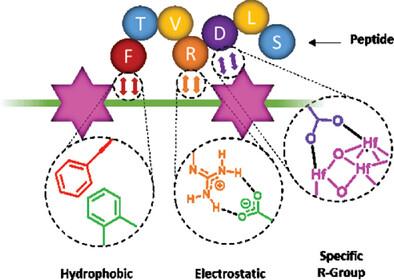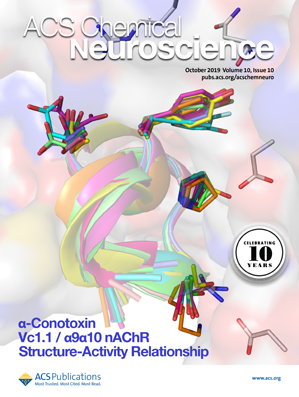Phage Display Against 2D Metal–Organic Nanosheets as a New Route to Highly Selective Biomolecular Recognition Surfaces
IF 4.1
3区 医学
Q2 BIOCHEMISTRY & MOLECULAR BIOLOGY
引用次数: 0
Abstract
Peptides are important biomarkers for various diseases, however distinguishing specific amino-acid sequences using artificial receptors remains a major challenge in biomedical sensing. This study introduces a new approach for creating highly selective recognition surfaces using phage display biopanning against metal–organic nanosheets (MONs). Three MONs (ZIF-7, ZIF-7-NH2, and Hf-BTB-NH2) are added to a solution containing every possible combination of seven-residue peptides attached to bacteriophage hosts. The highest affinity peptides for each MON are isolated through successive bio-panning rounds. Comparison of the surface properties of the MONs and high-affinity peptides provide useful insights into the relative importance of electrostatic, hydrophobic, and co-ordination bonding interactions in each system, aiding the design of future MONs. Coating of the Hf-BTB-NH2 MONs onto a quartz crystal microbalance (QCM) produced a five-fold higher signal for phage with the on-target peptide sequence compared to those with generic sequences. Surface plasmon resonance (SPR) studies produce a 4600-fold higher equilibrium dissociation constant (KD) for on-target sequences and are comparable to those of antibodies (KD = 4 x 10−10 m). It is anticipated that insights from the biopanning approach, combined with the highly tunable nature of MONs, will lead to a new generation of highly selective recognition surfaces for use in biomedical sensors.

针对二维金属有机纳米片的噬菌体展示是获得高选择性生物分子识别表面的新途径
肽是各种疾病的重要生物标志物,但利用人工受体区分特定氨基酸序列仍是生物医学传感领域的一大挑战。本研究介绍了一种针对金属有机纳米片(MONs)使用噬菌体展示生物平移来创建高选择性识别表面的新方法。将三种 MON(ZIF-7、ZIF-7-NH2 和 Hf-BTB-NH2)添加到含有附在噬菌体宿主上的七残基肽的各种可能组合的溶液中。通过连续的生物筛选,分离出每种 MON 的最高亲和力肽。通过比较 MON 和高亲和力肽的表面特性,可以深入了解静电、疏水和配位键相互作用在每个系统中的相对重要性,从而有助于未来 MON 的设计。将 Hf-BTB-NH2 MONs 涂覆在石英晶体微天平(QCM)上,与普通序列的噬菌体相比,具有目标肽序列的噬菌体产生的信号高出五倍。表面等离子体共振(SPR)研究显示,目标序列的平衡解离常数(KD)高出 4600 倍,与抗体的平衡解离常数(KD = 4 x 10-10 m)相当。预计生物平移方法的见解与 MONs 的高可调性相结合,将产生用于生物医学传感器的新一代高选择性识别表面。
本文章由计算机程序翻译,如有差异,请以英文原文为准。
求助全文
约1分钟内获得全文
求助全文
来源期刊

ACS Chemical Neuroscience
BIOCHEMISTRY & MOLECULAR BIOLOGY-CHEMISTRY, MEDICINAL
CiteScore
9.20
自引率
4.00%
发文量
323
审稿时长
1 months
期刊介绍:
ACS Chemical Neuroscience publishes high-quality research articles and reviews that showcase chemical, quantitative biological, biophysical and bioengineering approaches to the understanding of the nervous system and to the development of new treatments for neurological disorders. Research in the journal focuses on aspects of chemical neurobiology and bio-neurochemistry such as the following:
Neurotransmitters and receptors
Neuropharmaceuticals and therapeutics
Neural development—Plasticity, and degeneration
Chemical, physical, and computational methods in neuroscience
Neuronal diseases—basis, detection, and treatment
Mechanism of aging, learning, memory and behavior
Pain and sensory processing
Neurotoxins
Neuroscience-inspired bioengineering
Development of methods in chemical neurobiology
Neuroimaging agents and technologies
Animal models for central nervous system diseases
Behavioral research
 求助内容:
求助内容: 应助结果提醒方式:
应助结果提醒方式:


